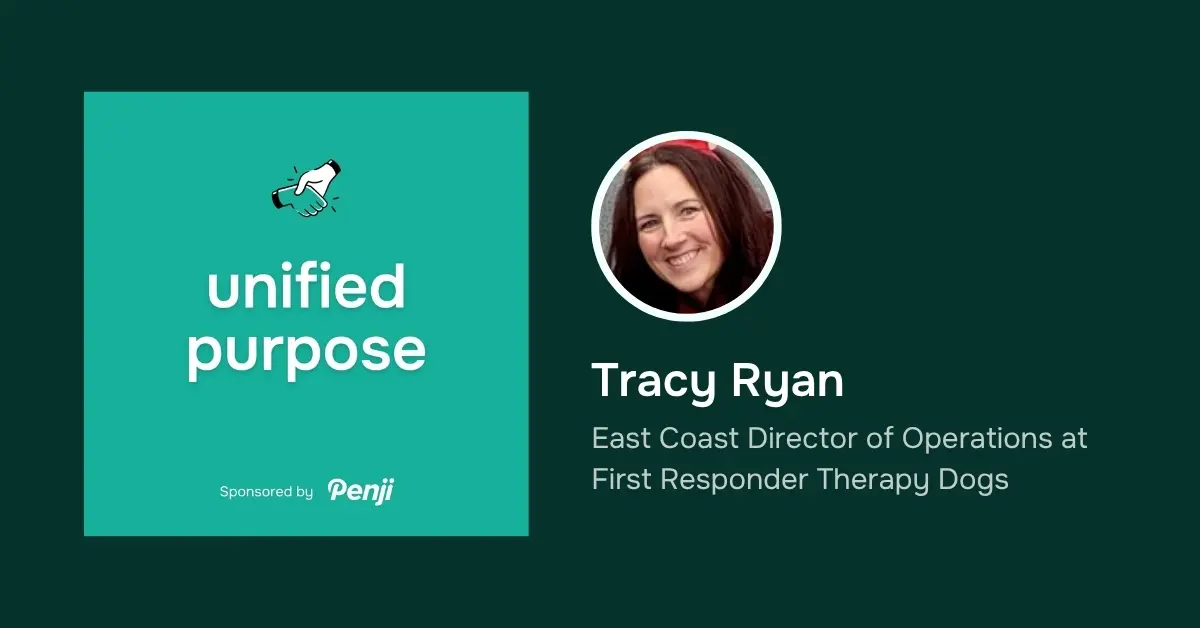
Introduction and Icebreaker Game
Daniela: Hello, everybody. Welcome to Unified Purpose. This is a podcast where we share inspiring tales of compassion, resilience, and community spirit. And you guys know me, I’m your host, Daniela. I’m Pedgy’s partnership coordinator. And I’m super excited because today we have a really cool guest, Tracy Ryan from First Responder Therapy Dogs. Hi, Tracy. How are you doing?
Tracy Ryan (TR): Hi, Daniela. Thank you so much for having us. I’m doing great.
Daniela: I’m so excited to have you today on the podcast. Before we start, though, I do have a small game prepared for you.
TR: Sure.
Daniela: It’s kind of just to break the ice and warm us up, right? Your website, for people watching who are not familiar, First Responder Therapy Dogs, obviously, they have therapy dogs. And I looked at some of the names that you guys have there of the dogs, and I came up with a few fake ones. I just want to see if you remember all of the names of the dogs. So, I’m going to say some names of dogs, and I want you to tell me if they’re from your non-profit or if they’re just made-up names that I have, okay?
TR: Okay.
Daniela: The first one is Maverick.
TR: Maverick is ours.
Daniela: Yes. Good. Sir Snuggles A Lot.
TR: Sir Snuggles A Lot, not ours.
Daniela: Yes, correct. Tank.
TR: Tank is ours.
Daniela: Yes, correct. Butterscotch.
TR: No, we do not have a Butterscotch to my knowledge.
Daniela: Yes, good. Ruger?
TR: No.
Daniela: No? Ruger maybe? Is it pronounced Ruger?
TR: Oh, Ruger. I think we do have a Ruger.
Daniela: Yes, you do have a Ruger. And last one, Tofu.
TR: I don’t think we have a Tofu.
Daniela: No, no Tofu. Okay. So, you clearly are the expert here. You passed the test! So, we have officially gotten warmed up, and now we know that you really do know what you’re doing. But for everybody watching who is not familiar with what you guys do, what you’re all about, please tell us all about it and what you guys would like our audience to know who are not familiar with it.
TR: Absolutely. So, First Responder Therapy Dogs is a national non-profit. We actually started out in the California area, and we are currently in 46 states with a little over 400 teams that have certified with us. We provide assistance and mental health support to first responders across the country through the use of trained and certified therapy dogs. Our mission is pretty simple: we take our dogs, and when I say a therapy dog team, that’s one handler and one canine. The canine goes through different assessments to make sure that they’re a good fit with our organization. The handler also does some different things to make sure they’re a good fit with our organization. Once they are certified, they’re able to visit everyone from firefighters to police officers, dispatchers, EMS personnel, hospitals, search and rescue teams, and wildland base camps. Depending upon the area that they reside, it can fluctuate a bit in terms of who they’re seeing, but they’re able to provide therapy dog support to the first responders while they’re on shift most of the time. It’s a wonderful break in the day of most first responders. They genuinely love the use of the dogs. Most people have a dog at home, and I say all the time, your own dog can be your therapy dog in a way. They’re excited to see you when you come in the door, they’re sad when you leave, and our dogs do the same thing, but at their workplace, which is a little different. It’s such a simple thing, but it genuinely brightens people’s days immensely when we enter the building.
Daniela: Yeah, I remember my friend told me a story one time about how she, when COVID happened, she ended up having to do her lockdown by herself in her house, and it was really depressing for her. She told me literally the only thing that was sort of keeping her going was that she had a dog, and that her dog required her to wake up, feed it, and take the dog for a walk. And that routine kept her motivated to not lose track of her life. I could totally see where you’re coming from with that. It makes sense.
TR: Yeah, absolutely.
The Start of First Responder Therapy Dogs
Daniela: Tracy, I’m super interested in a lot of the stuff that you guys do, but I’m actually curious to ask you, how did the organization start? Like, what inspired the foundation of this?
TR: Absolutely. Yeah. So, our organization started with one dog. She’s named Karath, and she’s almost six years old. She lives out in California, and her handler is Heidi Carmen, the founder and executive director of First Responder Therapy Dogs. Karath’s story is a very unique one. She actually started in Guide Dogs with the Blind, and they don’t call it failing out of that job; they call it career changing. She was just too friendly to be with that job, so Heidi was able to adopt her. Heidi started doing therapy work with Karath in a hospital setting, and from there, Karath met quite a few first responders. Heidi noticed Karath’s love for uniforms, her natural affection towards people coming into the hospital, and she quickly started bringing her to fire stations. The story started very small, with one or two teams, all based in California. When I certified in 2022 with my dog Sparky, we were the twelfth team across the country. It was still predominantly West Coast-based at that time. We were the first team on the East Coast. Since then, from 12 teams in 2022, we are now over 400 teams in 46 states. A lot of our expansion has been through word of mouth, people seeing us at events, or hearing about us through social media. The amount of people who inquire about our organization is wonderful. It’s been one of the most unbelievable experiences to witness from the ground up.
Daniela: That’s amazing. What I’m curious about is, when you are trying to train these dogs, my experience with my dog is that she gets really stressed out very easily if she’s put in situations outside of her comfort zone. How do you guys handle this and train them to interact in different settings without it being a stressful situation for them?
TR: It’s interesting. Just like people, some dogs are definitely born to be more acclimated to the work than others. My two dogs, Sparky and my second one, Blaze, are polar opposites in personality. From the time they were eight weeks old, I started working with them, socializing them, taking them to pet-friendly stores like Lowe’s and Home Depot, just walking around and getting used to the sounds and smells. It took a lot longer with Sparky, who was more heightened to sounds and smells. Blaze, on the other hand, is much more laid back. For every dog, the process is a little different. But what I will say is all the dogs love the job. It’s not always the right fit for every dog, though. To get certified, the dog has to pass the Canine Good Citizenship Test, which is like the SATs for dog training. This ensures they’re obedient and can handle different settings, noise, and other dogs. Then we observe their behavior in more chaotic settings like firehouses or stations with sirens going off, to ensure they can handle the noise. It’s always a work in progress. Some dogs, like Sparky, are more sensitive, and you never know what will happen next, like when we visited an event, and she saw a mascot, which she had never been trained for. It was a moment we had to work through, but we always keep going, and our dogs adjust.
Pushing Through Skepticism
Daniela: Have you faced any pushback with your mission? The concept of therapy dogs is still kind of new, and I wonder how that process has gone. Have you had to back up what you do with research or studies?
TR: I would say we’ve actually had less pushback than expected. However, the most significant challenge we face is dealing with the stereotype of first responders being tough and not discussing emotions. But through research, statistics, and tracking suicide rates and substance abuse in first responders, we’ve come to the realization that they are indeed experiencing major trauma. When I first started, I called some departments, and some were unfamiliar with therapy dogs, so I had to explain what it meant. Some thought we’d be doing counseling, but that’s not our job. We’re just bringing in dogs that provide support. Once we get into a station, most of the time, they immediately see the benefits. We’ve had some pushback, but we meet people where they’re at, and through events and social media, we’ve made great strides in getting the message out. Therapy dogs have been around for decades in hospitals and schools, and we’re just now starting to see more acceptance in the first responder community.
Conclusion
Daniela: Social media is such an asset for marketing and getting the name out there for organizations like yours, especially since you can connect with people easily. It’s a great way to do it in a cost-effective manner, which is always a concern for non-profits. I think it’s amazing what you guys are doing.
TR: Thank you. There’s a lot of science now connecting time spent with dogs to reduced stress hormones and increased happy hormones. It creates a whole psychological and physiological effect. It’s such a simple tool, but it works wonders. We’re just one additional tool, and in conjunction with other methods, we provide meaningful support.
Daniela: I totally agree with that. Thank you so much for being on the podcast today, Tracy.
TR: Thank you for having me.
Daniela: Guys, if anything resonated with you today, go visit Tracy’s website. I’ll add the links in the description. You can donate, get certified, or just learn more. Don’t forget to subscribe and interact with this video. Thank you for listening.









